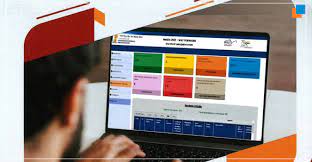
NeSDA Way Forward Annual Report 2023
NeSDA Way Forward Annual Report 2023
GS-2: Government Policies and Interventions
(UPSC/State PSC)
Important for Prelims:
Key Features of NeSDA Way Forward Report, 2023, Information and Communication Technology (ICT), National Satellite-Based Computer Network (NICNET), National e-Governance Plan (NEGP), Digital India Programme, National Informatics Center (NIC).
Important for Mains:
NeSDA Way Forward Report, Key Features of 2023, Challenges before e-Services, About e-Services, Importance of e-Services, Major Initiatives of Government of India related to e-Services, Way Forward.
Feb. 13, 2024
Why in news:
Recently, the Department of Administrative Reforms and Public Grievances (DARPG), Ministry of Public Grievances and Pensions, has released the 'Annual NeSDA Way Forward Report' for 2023.
- This report highlights the significant progress made by the States and UTs during the year under the NESDA framework in terms of mandatory e-services and total e-services.
Key Features of the Report:
- E-services: As per the latest data, states and union territories are providing a total of 16,487 e-services in December, 2023, while the number was 11,614 in April, 2023.
- Union Territory “Jammu and Kashmir” tops the list of States/UTs with maximum e-services by providing 1,117 e-services.
- Saturation level: 76% saturation level of potential essential e-services has been achieved by States and UTs, which is higher than 69% under NESDA 2021.
- State Performance: Apart from the Union Territory of Jammu and Kashmir, the States of Kerala, Assam and Odisha are providing 100 per cent e-services through their respective integrated portals.
About e-Service:
- E-service means a service in which Information and Communication Technology (ICT) is used.
- These are Internet-based online services, in which legitimate transactions of purchase and sale are possible transparently.
Importance of e-Services:
- E-services have a significant impact on the socio-economic landscape of India. It enhances governance, promotes economic growth and improves the ease of doing business in India. It includes the following services:
- Digital Infrastructure: India has set an ambitious target of doubling its economy to $5 trillion in five years.
- The country has made several efforts to become more digital, and the Digital India Mission is envisioned to be based on digital security and trust.
- E-commerce: The e-commerce sector in India is the fastest growing sector and is expected to grow at a compound annual growth rate of 41% to cross US$ 103 billion by 2020.
- In 2015-16, e-commerce spending was 2% of total retail spending and has become a major driver for creating new markets. Its contribution to GDP is expected to be 4% by 2020.
- Electronic Banking: India has seen considerable growth in e-banking due to the huge number of Internet users in India (about 700 million Internet users in 2020, the second largest in the world and expected to grow to more than 974 million users by 2025). There is a possibility. Increasing smartphone and mobile internet users.
- Education: Digital education brings efficiency in teaching and engaging students. Teachers experience greater social-emotional benefits after learning to use technology in education and report greater efficiency through better content access, more effective lesson planning, and classroom management.
Challenges faced by e-services:
- E-waste related challenges: The development of ICT sector has led to rapid increase in the use of electronic devices. Environmental challenges have increased due to the generation of millions of metric tons of e-waste due to consumption of electronic and electrical equipment.
- Economic Challenges: India's falling “e-readiness rank” indicates that ICT usage in India is very low.
- Factors like privacy and security related to user's personal information, digital divide etc. are also major challenges for the implementation of e-governance in India.
- E-learning Challenges: The COVID-19 pandemic has made India's education system extremely biased and flawed. The main thrust of providing learning opportunities during school closures is online learning. However, this has led to increased inequality, academic issues leading to poor quality education and undue emphasis on online education.
- Rural Education Challenges: In rural areas, financial issues, lack of guidance, lack of infrastructure and faculty and gender inequality are significant challenges to education.
- Remote work challenges: India's remote work ranking has declined due to struggles with e-infrastructure, low English proficiency and internet problems.
Initiatives of Government of India related to e-services:
- In 1970, the Department of Electronics was established (the first major step towards e-governance in India).
- In 1977, District Information System Program launched by National Informatics Center (NIC).
- In 1987, National Satellite-based Computer Network (NICNET) launched for e-governance.
National e-Governance Plan (NEGP):
- It collectively integrates all e-governance initiatives across the country. NeGP, approved in 2006, consists of 31 mission mode projects. Currently, NeGP has been merged into the Digital India programme.
- Various e-payments like BHIM-UPI, GeM, GSTN, DigiLocker, UMANG, Jeevan Praman, e-Hospital etc. Services are being provided.
National e-Governance Plan 2.0:
- This is an important part of the Digital India programme.
- It was approved in 2015 with the vision of “Transforming e-Governance for Transforming Governance”.
- Currently 44 mission mode projects are implemented under this scheme at various stages.
Way forward:
E-governance is gaining momentum in India, but public awareness and digital divide are important issues that need to be addressed.
The success of e-governance measures largely depends on the availability of high-speed internet, and the nationwide roll-out of 5G technology in the near future will strengthen our resolve.
Source: Economic Times
------------------------------------------------
Mains Exam Questions:
In the light of NeSDA Way Forward Annual Report 2023, outline the way forward to address the challenges facing e-services in India.
Critically examine the major initiatives of the Government of India related to e-services.